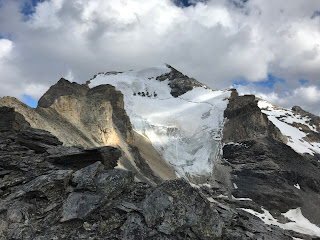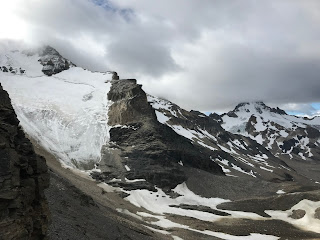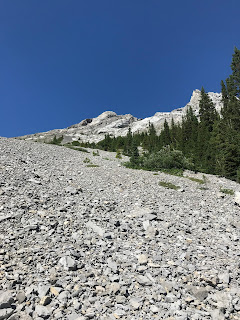 |
| North West aspect of Mt. Delphine from near Peter Pass. |
August 9, 2020 teamed up with my old climbing buddy for a second attempt at Mt. Delphine. Raff and I have some bad beta about the condition and length of the McDonald Creek Forest Service Road (FSR) back on July 22, 2012 when we attempted to day trip Delphine from McDonald Creek. The road ended way sooner than hoped and the valley looked very difficult to ascended, since we only had the day, we bailed to Jumbo Pass and had an enjoyable day scrambling Bastille Mountain. See trip report here.
Raff had obtained some beta from long time and well experienced local climber David Salahub. David and this team ascended Mt. Delphine from the end of the McDonald Creek FSR back in the Fall of 1988. His information was the same as our old beta from 2012, but now we knew a single day push was not possible and brought bivy gear.
From Calgary we had an early start, drove to Radium and then to the McDonald Creek FSR and the road ended even earlier than our 2012 trip, at a creek crossing where the bridge was removed. Back in 2012, we were able to drive across this bridge, but only made it an additional 400 metres to a huge avalanche wash out across the road. We parked at the old bridge site and loaded up for the hike.
 |
| Map doesn't show parking location. Map indicates bivy site, approach to Delphine and our ascent/descend route. |
The day was gorgeous and super warm. The wading the of creek was straight forward and refreshing. Then a simple walk up the old road for a few kilometres. Where the road ends there was some light bushwacking to reach the bottom of the head wall way below Peter Pass.
 |
| Nice easy hike up the road for a few km's. |
The road ends is a few km's, find we picked our way through an old cut block to the base of the head wall, basically no bushwacking. We started picking our up, easy at first, we did spy a few cairns about halfway up, the exit at the top required a few hands on difficult steps to ascend up, kept things interesting.
 |
| View from the top of the head wall down the McDonald drainage. |
 |
| Once above the headwall, easy scree hike towards Mt. Peter. |
Once above steep head wall, simply head west towards Mt. Peter, easy travel on nice scree and a few small snow patches.
 |
| View to Mt. Peter. Summit is the left high point. I bet the snow couloir climbs well to the low point right of the summit. |
Once we arrived at our beautiful location, we wandered around a bit to soak up the beautiful alpine tarns and the great views. The glacier to access Peter Pass was small and very steep, a full alpine climbing adventure. Raff volunteered to scope out a route and headed up the slope more east of Peter Pass to find us an efficient line; I started dinner. Raff found a great line, so we had dinner and headed to bed. Overnight it got very windy and the day started very cloudy with all the high summits in cloud. We had some coffee and breakfast and headed up.
 |
| Climbing day. The morning was cold and cloudy. Raff on the edge of the glacier on the way to Peter Pass. |
 |
| View to Mt. Peter over Peter Pass. |
Overall, fairly straight forward to reach Peter Pass. From camp we started on snow patches, a bit of scrambling, back to some steep snow, reached the edge glacier, which was very broken here, then traversed below the glacier on an exposed rock ledge. Eventually we reached a flat section of the glacier, traversed easily over to the rock of Peter Pass. From the pass you head south and drop about 300 metres to reach the edge of the glacier on the North West side of Mount Delphine. All easy, but not fun, just scree slogging. Funny thing happened as Raff and I were slogging up the edge of the glacier, ascending into the clouds, we saw a solo climber descending. Turns out Raff knew the climber, of course he did. Matt is from Invermere and a seriously fit climber. Matt backed off on the summit ridge because of icy conditions and basically no visibility. Well, since he knew Raff and liked the concept of a rope and extra the security of additional climbers, he decided to join us for the summit. Us three continued our slog up scree beside the steep glacier. Nearing the start of the summit ridge, visibility was basically zero. Soon after gaining the ridge, the ice of the face glacier meets the ridge, along with many large cornices.
 |
| Nearing the upper North East ridge of Mt. Delphine. The glacier can be seen on the summit ridge. (Photo taken on descent) |
 |
| Nearing the upper North East ridge on the ascent. |
On the upper North East ridge, the first section was easy climbing with a mix of rock steps and snow patches. About one third of the way up the ridge, the ridge becomes covered with glacier ice, and a very exposed view with a steep drop down the North West face. Just before the ice, we roped and continued with a running belay of ice screws. Matt skillfully lead us to the summit of Mt. Delphine after a traverse of icy slopes and some interesting cornices. Once on the summit, the skies cleared more and more and we were treated with excellent views of the surrounding Purcell mountains.
After enjoying the improving summit views for awhile, we headed down in clearing conditions. We traveled quickly to the bottom of the North West glacier. We took a long lunch break and had a few laughs and interesting conversation before heading our separate ways. Matt had approached via Farnham Creek, so he headed back to his bivy site, eventually back to his vehicle to head home to Invermere that day. Raff and I had planned to spent a second night at our bivy. Raff and I plodded back up hill to Peter Pass, then back to our bivy site. Dinner and early to bed. Up with the sun on the third day and started our return to Raff's vehicle low down in the McDonald Creek drainage. Overall, a great trip, and great to climb with an old friend. Good times in 2020.
 |
| View from our bivy back to the mighty Mt. Farham. |
 |
| The glorious Mt. Farnham and Farnham Tower. Tower is the big bump on the far right ridge line, a separate official summit and over 11,000 ft. |
 |
| Just below the head wall, beautiful flowers in McDonald Creek. |
 |
| End of a great trip. |

























































